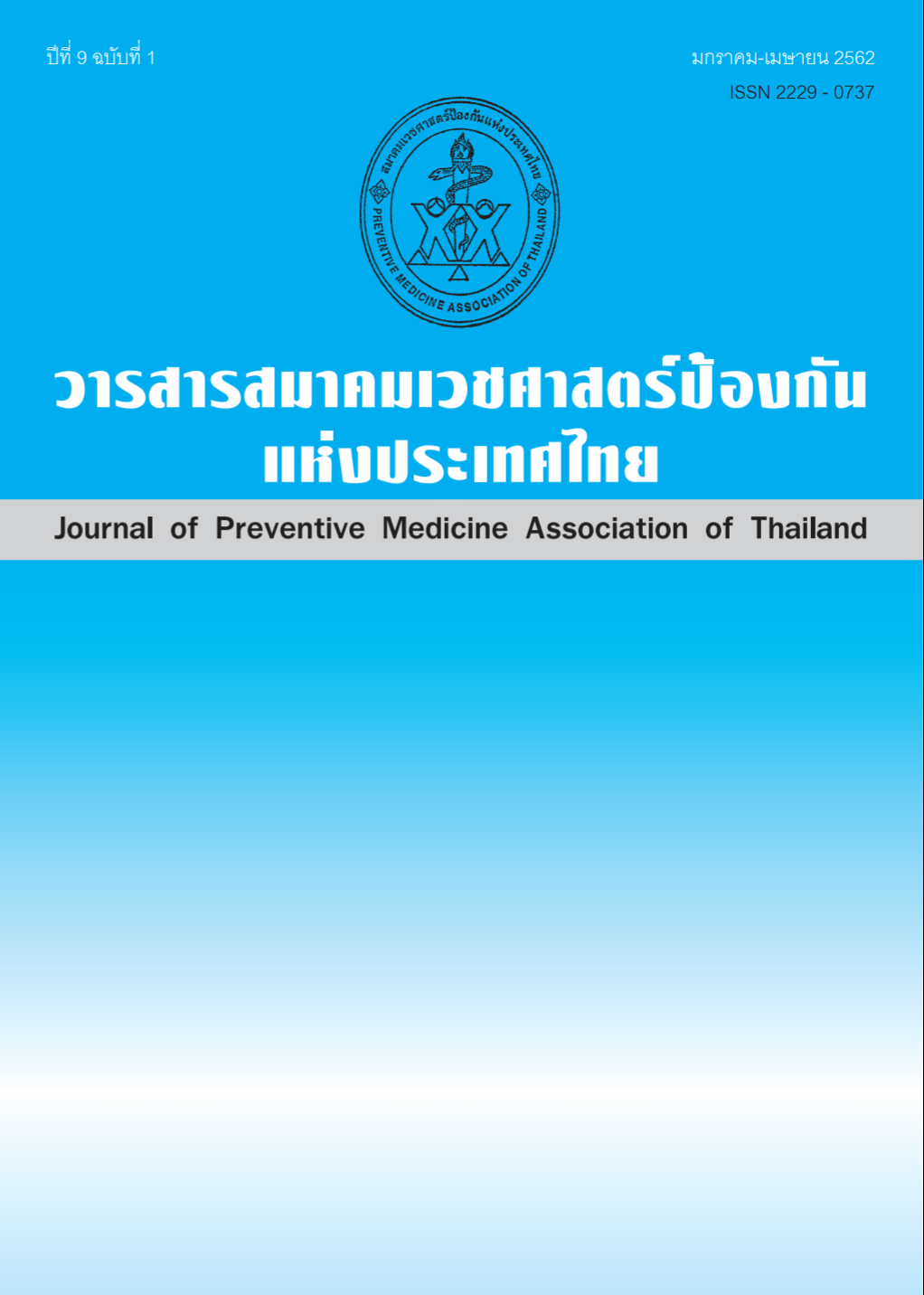Prevalence and Associated Factors of Hand Dermatitis Among Spa Massage Therapists in Bangkok and its Vicinity
Keywords:
prevalence, occupational skin disorder, hand dermatitis, spa massage therapistAbstract
This study aimed to find out the prevalence and associated factors of hand dermatitis among spa massage therapists in Bangkok and its vicinity. The study design was a cross-sectional study; subjects were 348 spa therapists from Bangkok and its vicinity. The data were collected by questionnaires, adapted from Nordic Occupational Skin Questionnaire. Individual subjects were examined their hands by the investigator, and were photographed for their skin lesions of hand dermatitis, then verified by the dermatologist. Data were analyzed by descriptive statistics and inferential statistics (Pearson Chi-square test, Fisher’s exact test and multiple logistic regression). The results showed that prevalence of hand dermatitis was 14.4%. Statistically significant factors associated with hand dermatitis (p-value<0.05) were an individual who has history of atopic dermatitis (Adj. OR 10.01, p-value<0.001) or who uses aromatherapy products containing either lavender (Adj. OR 2.18, p-value=0.026) or eucalyptus (Adj. OR 2.05, p-value=0.038). Other factors, environmental and hobby or domestic work, were not associated with hand dermatitis. In conclusion, hand dermatitis should be observed and monitored in people at risk, including those who have history of atopic dermatitis. The knowledge about hand dermatitis should be provided including the awareness about aromatherapy products containing either lavender or eucalyptus and how to look after themselves after exposure to such products.
References
2. พระราชบัญญัติสถานประกอบการเพื่อสุขภาพ พ.ศ. 2559. (2559, 31 มีนาคม). ราชกิจจานุเบกษาเล่มที่ 133 ตอนที่ 30ก. หน้า 10-24.
3. Boonchai W, Iamtharachai P, Sunthonpalin P. Occupational allergic contact dermatitis from essential oils in aromatherapists. Contact Dermatitis 2007;56:181-2.
4. Trattner A, David M, Lazarov A. Occupational contact dermatitis due toessential oils. Contact Dermatitis 2008;58(5):282-4.
5. Boonchai W, Iamtharachai P, Sunthonpalin P. Prevalence of Allergic Contact Dermatitis in Thailand. Dermatitis 2007;19:142-5.
6. ประณีต สัจจเจริญพงษ์. Occupational Dermatoses [ออนไลน์]. 2551 [เข้าถึงเมื่อ 17 ตุลาคม 2559]. เข้าถึงได้จาก http://envocc.ddc.moph.go.th/uploads/media/direction/OccupationalDermatoses.pdf/
7. Meding B, Swanbeck G. Occupational hand eczema in an industrial city. Contact Dermatitis 1990;22:13-23.
8. Flyvholm MA, Susitaival P, Meding B, Kanerva L, Lindberg M, Svensson A, et al. Nordic occupational skin questionnaire NOSQ-2002. Copenhagen: Nordic Council of Ministers, 2002.
9. Crawford GH, Katz KA, Ellis E, James WD. Use of Aromatherapy Products and Increased Risk of Hand Dermatitis in Massage Therapists. Arch Dermatol 2004;140(8):991-6.
10. Svensson A, Lindberg M, Meding B, Sundberg K, Stenberg B. Epidemiology and Health Services Research Self-reported hand eczema: symptom-based reports do not increase the validity of diagnosis. Br J Dermatol 2002;147(2):281-4.
11. Lantinga H, Nater JP, Coenraads PJ. Prevalence, incidence and course of eczema on the hands and forearms in a sample of the general population. Contact Dermatitis 1984;10(3): 135-9.
12. Darlenski R, Fluhr JW. Influence of skin type, race, sex and anatomical location on epidermal barrier function. Clinics in Dermatology 2012;30(3):269-73.
13. Muizzuddin N, Hellemans L, Overloop LV, Corstjens H, Declercq L, Maes D. Structural and function differences in barrier properties of African American, Caucasian and East Asian skin. J Dermatol Sci 2010;59:123-8.
14. Rystedt I. Contact sensitivity in adults with atopic dermatitis in childhood. Contact Dermatitis 1985;13:1-8.
15. Shmunes E, Keil J. The role of atopy in occupational dermatoses. Contact Dermatitis 1984;11(3):174-8.
16. Posadzki P, Alotaibi A, Ernst E. Adverse effects of aromatherapy: A systemic review of case reports and case series. International Journal of Risk and Safety in Medicine 2012;24(3):147-61.
17. Schaller M, Korting HC. Allergic airborne contact dermatitis from essential oils used in aromatherapy. Clin Exp Dermatol 1995;20(2):143-5.
18. กิตติพล ไพรสุทธิรัตน์, สุนทร ศุภพงษ์, ประณีต สัจจเจริญพงษ์. ความชุกและปัจจัยที่เกี่ยวข้องกับโรคผิวหนังอักเสบบริเวณมือในผู้ประกอบอาหารโรงพยาบาลในสังกัดกรมการแพทย์ และโรงพยาบาล ศูนย์ภาคกลาง. วารสารสมาคมเวชศาสตร์ป้องกันแห่งประเทศไทย 2560;7(2):148-59.
19. Engebretsen KA, Johansen JD, Kezic S, Linneberg A, Thyssen JP. The effect of environmental humidity and temperature on skin barrier function and dermatitis. 2016;30(2):223-49.
Downloads
Published
How to Cite
Issue
Section
License
บทความที่ลงพิมพ์ในวารสารเวชศาสตร์ป้องกันแห่งประเทศไทย ถือเป็นผลงานวิชาการ งานวิจัย วิเคราะห์ วิจารณ์ เป็นความเห็นส่วนตัวของผู้นิพนธ์ กองบรรณาธิการไม่จำเป็นต้องเห็นด้วยเสมอไปและผู้นิพนธ์จะต้องรับผิดชอบต่อบทความของตนเอง






